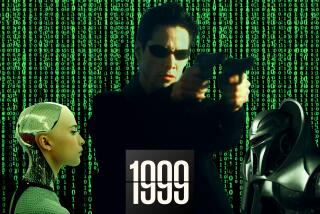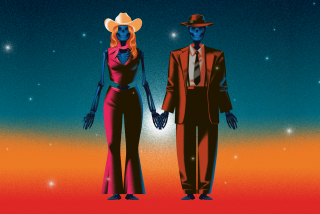Summer sci-fi: an up-to-minute reflection of our transnational world
It may seem unlikely, but intergalactic robots, a train that traverses the globe and a woman with drug-induced superpowers indeed all have something to say about the reality of our actual right now even while imagining uncanny alternate paths.
Michael Bay’s “Transformers: Age of Extinction,” Bong Joon-ho’s “Snowpiercer” and Luc Besson’s “Lucy” all engage the multiculturalism of the global economy era both in front of and behind the camera. Matt Reeves’ “Dawn of the Planet of the Apes,” Doug Liman’s “Edge of Tomorrow,” Gareth Edwards’ “Godzilla” and recent indie releases such as Mike Cahill’s “I Origins” and Jonathan Glazer’s “Under the Skin” have also grappled with the intersection of sci-fi fantasy and oncoming reality.
These are pictures as up to the minute in their engagement with the film business, moviegoing and the technology of image-making as the stories they tell.
Because the movies of summer typically have a certain scale, a bigness, about them, it makes sense that they would be invested in technological wizardry both behind the scenes and in their narratives. A handful of recent movies have been digging into science fiction not for any sense of scientific reality or truth but rather for the imaginative freedom it provides. Sci-fi has long been seen as a place for allegories of human existence, which is to say that the fiction is more important than the science. If anyone would like to truth squad the “Transformers” concept of an infinitely mutable matter known as “transformium,” or whether achieving 100% of the human cerebral capacity would make us powerful superbeings, as in “Lucy,” feel free.
“Transformers” director Bay is quite simply one of the most challenging characters in Hollywood today, someone who is easy to both dismiss or overvalue as thinker and filmmaker. Yet he is impossible to overlook as a cultural figure.
Bay’s previous movie, last year’s “Pain & Gain,” may be the closest he’ll ever come to a small-scale personal film, and yet it was still bold and brash and full of girls, guns, destruction and a cynical side-eye view of humanity. “Age of Extinction,” the fourth movie in the “Transformers” franchise and on track to be one of the biggest box office successes of the year, refuses deeper engagement at every turn, purposefully remaining a film of surfaces, images and sensory overload.
In this way, the “Transformers” franchise has become more interesting as an object for thinking about the state of the business than as actual moviemaking or a vehicle for ideas. Made in part with Chinese financing, the film is set in part in Beijing and Hong Kong, and the story swiftly moves from the U.S. to China when a villainous industrialist needs an unsupervised research facility, where even random delivery men know martial arts.
But there is nothing in the movie itself quite as nail-bitingly dramatic as the chaotic real-life scene reported by The Times’ Julie Makinen of the team behind the film recently struggling to appease a chainsmoking Chinese hotel executive who felt he wasn’t getting enough out of his product placement deal.
And as one computer-generated vehicle-monster clashes with yet another computer-generated vehicle-monster — there are even robot dinosaurs! — the eye and mind dowander, so it’s hard not to notice the conspicuous billboards dotting the background, including a local tourism board, or the bus — wrapped with a Victoria’s Secret ad — that gets crushed.
While “Transformers” is an example of global cinematic capitalism and its discontents, “Snowpiercer” more deftly integrates such ideas into its storytelling. After a man-made intervention to fight global warming plunges the planet into a new ice age, a nonstop supertrain on a track that spans the globe contains all that is left of humanity. A band of have-nots living in cramped squalor at the back of the train battle their way forward through the luxury elites taking up most of the cars on their way toward the “sacred engine” at the front.
“Snowpiercer,” directed by a Korean filmmaker, based on a French graphic novel, shot largely in the Czech Republic and with a multinational cast speaking mostly but not exclusively in English, embodies the polyglot stew of modern life in a way that feels natural, not exotic. The film, already a hit around the globe, has been released in the U.S. through an ambitious strategy that put it on VOD platforms as theatrical locationswere being added.
“Snowpiercer” and its release embody the way things are in flux right now, with uncertainty on all sides. Tilda Swinton’s superciliously imperious administrator speaks to the importance of knowing your place within the hierarchy, saying you wouldn’t wear a shoe as a hat because “this is Size 10 chaos.”
Stanley Tucci has a brief moment in “Transformers” where his character — something of a cross between Steve Jobs and a Bond villain until a late-breaking discovery of conscience — has an epic meltdown in an elevator, and the actor relishes the moment, a rare bit of fun in the movie. Besson’s “Lucy,” opening July 25, is an entire movie closer in pitch to that elevator scene, a giddy, gleeful spin-out. Where Bay’s latest “Transformers” often feels oppressive, Besson’s film feels liberating. (Not least because of their running times — “Lucy” being nearly 40% shorter.)
Scarlett Johansson plays the title character, a woman who after an accidental chemical overdose begins to utilize a higher percentage of her brain, gaining metaphysical powers, seemingly infinite knowledge and deeper understanding as she gets nearer to 100%. The character is introduced as something of a screwball party girl with a hint of underworld moll — I would welcome a prequel, “Lucy 2: Taipei Nights” — and so right from the start, the character seems more alive than anyone in “Extinction.”
Besson’s film is also a cross-cultural production: a French filmmaker working partly in Taiwan with an American star and a villain played by Korean actor Choi Min-sik. The writer-director, who helped bring a smart, stylized gloss to action filmmaking in an era pre-Bay with “La Femme Nikita” and “The Professional,” has more recently been overseeing the “Transporter” and “Taken” franchises as writer and producer. Besson’s light touch helps give “Lucy” its engaging energy and drive.
Besson gives plenty of screen time to — how to put this? — the generous jiggle of Johansson, though as only relatively modest ogling. Bay, on the other hand, deploys one of his signature scan-up-legs shots on a female character for no other reason. Megan Fox in the first “Transformers” film was at least introduced fixing a car, while in this film, Nicola Peltz’s female lead exists solely for her father and boyfriend to fight over who is saving her. In that way, this modern major franchise is becoming more regressive, not enlightened, as it goes along.
The summer sci-fi of Bay, Bong and Besson shows the range of what’s under the umbrella of Hollywood this season, mixing high tech, big ideas and fizzy fun. Each film in its own way also grapples with cultural cross-pollination and trans-national globalism both on-screen and off. From the overwhelming behemoth of “Transformers: Age of Extinction” to the hurtling allegories of “Snowpiercer” to the nimble philosophical lightness of “Lucy,” to get where we’re going, we’ve got to know where we’re at.
More to Read
Only good movies
Get the Indie Focus newsletter, Mark Olsen's weekly guide to the world of cinema.
You may occasionally receive promotional content from the Los Angeles Times.







